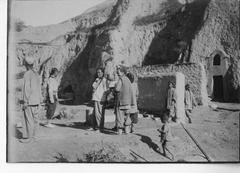Comprehensive Guide to Visiting Shaanxi, People’s Republic of China
Date: 13/08/2024
Captivating Introduction
Welcome to Shaanxi, where every corner whispers tales of emperors and warriors, and every street is a vibrant tapestry of culture and history. Picture this: you’re standing on ancient city walls, gazing over a city that once was the heart of a mighty empire. Shaanxi is often referred to as one of the cradles of Chinese civilization, having served as the capital for thirteen feudal dynasties over a span of more than 1,100 years (Wikipedia, Britannica).
The province’s principal city, Xi’an, is one of the Four Great Ancient Capitals of China and the eastern terminus of the Silk Road, which connected China to Europe, the Arabian Peninsula, and Africa (Travel with Bender). This historical significance is further underscored by its role as the starting point of the Silk Road in 130 BCE, which facilitated commerce between China and Europe, significantly impacting cultural and economic exchanges (UNESCO).
Whether you are a history enthusiast or a casual traveler, Shaanxi provides a unique and immersive experience into China’s illustrious past. From the awe-inspiring Terracotta Warriors to the vibrant Muslim Quarter, this province offers a blend of ancient wonders and modern-day marvels. Ready to uncover Shaanxi’s secrets? Download Audiala, our expertly crafted audio guide app, and let us lead you through a journey of discovery. It’s like having a witty local friend in your pocket!
Table of Contents
- Historical Significance
- Time-Traveling Adventure: Ancient Capitals and Dynasties
- The Silk Road: Where East Meets West
- Discover the Terracotta Warriors: A Quest for History
- The Tang Dynasty and Chang’an: A Glimpse into the Past
- Natural Disasters and Decline: A Tale of Resilience
- The Ming and Qing Dynasties: Shifting Powers
- The Long March and Modern Era: A New Dawn
- Cultural and Historical Sites: Hidden Gems Await
- The Xi’an City Wall: Stories in Stone
- The Muslim Quarter: A Sensory Overload
- Mount Huashan: A Hiker’s Paradise
- Visitor Tips: Plan Your Adventure
- Seasonal Highlights: The Ever-Changing Beauty
- Unveil Shaanxi’s Secrets with Audiala
Historical Significance of Shaanxi
Time-Traveling Adventure: Ancient Capitals and Dynasties
Shaanxi is often referred to as one of the cradles of Chinese civilization, having served as the capital for thirteen feudal dynasties over a span of more than 1,100 years. The province’s principal city, Xi’an, is one of the Four Great Ancient Capitals of China and the eastern terminus of the Silk Road, which connected China to Europe, the Arabian Peninsula, and Africa (Wikipedia).
The Zhou dynasty (1046–256 BCE) established its capital near modern Xi’an, marking the beginning of Shaanxi’s prominence. The Qin dynasty (221–206 BCE), which unified China for the first time, also had its capital in Shaanxi, specifically in Xianyang. The Han dynasty (206 BCE–220 CE) followed suit, establishing their capital in Chang’an, near modern Xi’an. This city remained a major political and cultural center through the Sui (581–618 CE) and Tang (618–907 CE) dynasties (Britannica).
The Silk Road: Where East Meets West
Xi’an’s significance is further underscored by its role as the starting point of the Silk Road in 130 BCE. This ancient trade route facilitated commerce between China and Europe, significantly impacting the cultural and economic exchanges between the East and the West. The city’s strategic location made it a melting pot of diverse cultures, religions, and philosophies (Travel with Bender).
Discover the Terracotta Warriors: A Quest for History
One of the most iconic historical sites in Shaanxi is the Terracotta Army, located in the Mausoleum of the First Qin Emperor. Discovered in 1974, this archaeological marvel consists of over 8,000 life-sized terracotta soldiers, horses, and chariots, each with unique facial features and expressions. This site provides invaluable insights into the military practices and artistic achievements of the Qin dynasty (UNESCO).
The Tang Dynasty and Chang’an: A Glimpse into the Past
During the Tang dynasty, Chang’an was the largest and most magnificent city in the world, boasting a population of over one million people. The city was a major religious center, hosting Buddhism, Taoism, Zoroastrianism, Nestorianism, and Manichaeism. The Big Wild Goose Pagoda, built in 652 CE, is one of the few remaining structures from this era and houses the library collected by the famous Buddhist monk Xuanzang (UNESCO).
Natural Disasters and Decline: A Tale of Resilience
Shaanxi has also been the site of significant natural disasters. One of the most devastating earthquakes in history occurred near Hua Shan in southeastern Shaanxi on January 23, 1556, killing an estimated 830,000 people (Wikipedia). This event, known as the 1556 Shaanxi earthquake, had a profound impact on the region’s development and infrastructure.
The Ming and Qing Dynasties: Shifting Powers
Under the Ming dynasty (1368–1644), Shaanxi was established with the founding of the Shaanxi Provincial Administration Commission in 1376. During this period, most visitors from Central and West Asia entered China via Shaanxi. The province continued to play a crucial role in China’s political and economic landscape, although it began to decline in importance after the capital moved to Beijing during the Ming dynasty (Wikipedia).
The Long March and Modern Era: A New Dawn
In the 20th century, Shaanxi gained prominence again as the endpoint of the Long March by Mao Zedong and the Chinese Communists. The Shaanxi Soviet at Yan’an became the base for the Communist Party of China during the Chinese Civil War. This period is crucial for understanding the modern political landscape of China (Wikipedia).
Cultural and Historical Sites: Hidden Gems Await
Shaanxi is home to numerous cultural and historical sites that offer a glimpse into its rich past. The Shaanxi History Museum in Xi’an houses over 130,000 artifacts, including relics from the Zhou, Qin, Han, and Tang dynasties. The museum provides a comprehensive overview of the province’s history and cultural heritage (Tourist Secrets).
The Huaqing Palace, located at the foot of Mount Li, is another significant site. With a history of nearly 3,000 years, it served as a retreat for emperors and is renowned for its hot springs and beautiful landscapes. The palace is particularly enchanting at night when it is illuminated, creating a magical ambiance (Travel with Bender).
The Xi’an City Wall: Stories in Stone
The Xi’an City Wall, built during the Ming dynasty, is one of the best-preserved ancient city walls in China. Stretching over 13 kilometers, it offers panoramic views of the city and serves as a testament to the architectural and engineering prowess of ancient China (China Highlights).
The Muslim Quarter: A Sensory Overload
The Muslim Quarter in Xi’an is a vibrant area that reflects the city’s multicultural heritage. The Great Mosque, built in 742 CE, is a unique blend of Islamic and Chinese architectural styles. The quarter comes alive in the evenings with bustling markets, offering a variety of local delicacies and handicrafts (Tourist Secrets).
Mount Huashan: A Hiker’s Paradise
Mount Huashan, one of China’s Five Great Mountains, is located near the city of Huayin in Shaanxi Province. Known for its steep and narrow paths, it is a popular destination for hikers and spiritual seekers. The mountain offers breathtaking views and is home to several Taoist temples (Tourist Secrets).
Visitor Tips: Plan Your Adventure
For those planning to visit Shaanxi, the best times are during spring and autumn when the weather is mild. Summers can be extremely hot, and winters are dry and cold. Allocate several hours to visit major sites like the Terracotta Army and the Shaanxi History Museum to fully appreciate their historical significance. It’s also advisable to explore the Muslim Quarter in the evenings to experience its lively atmosphere (China Highlights).
Seasonal Highlights: The Ever-Changing Beauty
Spring blooms bring the city to life, while autumn’s golden hues make Xi’an’s ancient walls look even more majestic. Shaanxi transforms throughout the year, offering unique events and phenomena to explore.
Unveil Shaanxi’s Secrets with Audiala
Ready to uncover Shaanxi’s secrets? Download Audiala and let our expertly crafted audio guides lead you through a journey of discovery. It’s like having a witty local friend in your pocket! Whether you’re a history enthusiast or a casual traveler, Shaanxi provides a unique and immersive experience into China’s illustrious past.
Call to Action
In conclusion, Shaanxi is a province that truly embodies the essence of China’s rich historical tapestry. From serving as the capital for thirteen feudal dynasties to being the starting point of the Silk Road, Shaanxi’s historical significance is unparalleled (Britannica). The province offers a myriad of experiences—from exploring the awe-inspiring Terracotta Warriors, walking atop the ancient Xi’an City Wall, to savoring the vibrant street food in the Muslim Quarter (China Highlights).
Shaanxi’s ever-changing beauty throughout the seasons, coupled with its rich cultural heritage and historical landmarks, makes it a must-visit destination for any traveler. Whether you’re hiking the perilous paths of Mount Huashan or marveling at the architectural prowess of the Big Wild Goose Pagoda, Shaanxi promises an adventure like no other (Tourist Secrets).
Ready to dive deeper into Shaanxi’s secrets and stories? Make sure to download Audiala, your ultimate tour guide app, for expert insights and hidden gems. With beautifully crafted audio guides, Audiala enhances your exploration experience, making it the perfect companion for curious travelers. Download Audiala before your visit and let the adventure begin!
References
- Shaanxi, 2024, Wikipedia Wikipedia
- Shaanxi, 2024, Britannica Britannica
- Things to do in Shaanxi, 2024, Travel with Bender Travel with Bender
- Xi’an, 2024, UNESCO UNESCO
- Terracotta Army, 2024, China Highlights China Highlights
- Muslim Quarter, 2024, China Highlights China Highlights
- Top Things to Do in Shaanxi, 2024, Tourist Secrets Tourist Secrets

















